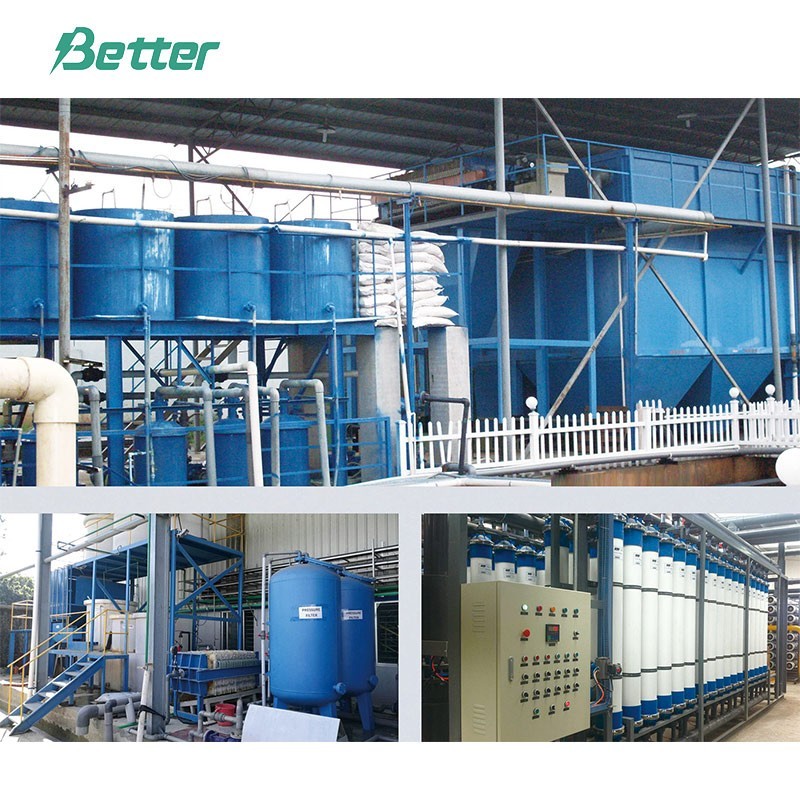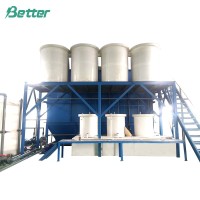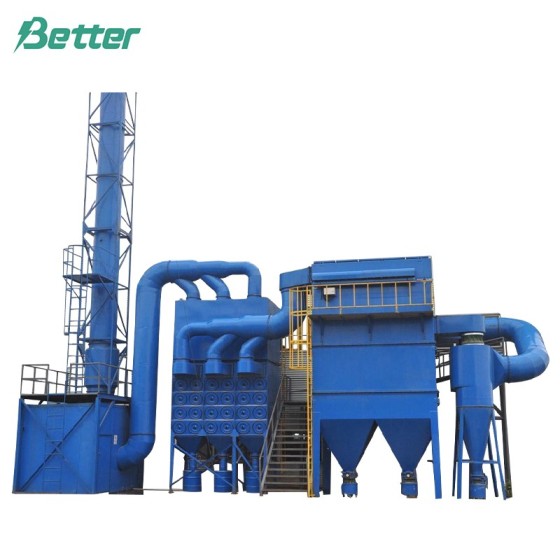Effluent Treatment System
Effluent treatment system applies to purifying the Lead acid waste water in the lead acid battery manufacturing process.
- BETTER
- CHINA
- Information
Lead Acid Waste Water Treatment System (Automatic)/Effluent treatment system
1. Summary
The program is designed to ensure that the wastewater treatment indicators meet the requirement of the national environmental emission standards. The design imitates the advanced electrical control technique, and combines our company's years of engineering experience. It has the advantages of advanced technology, reliability and stability, simple operation; emission will reach the standard, which is mainly reflected in the following aspects:
New combination technology:
1. PH modulating control, and then carried by the slope tube sedimentation process to achieve discharge water standard.
2. Sludge dried by box-type filter press, drying time is short with high efficiency.
3. Programmable controller for pumps, valves and other control objects to achieve the clock, water level, constant automatic operation.
Advanced system configuration:
Operating panel with world-class touch screen, more intuitive operation, LCD display, on-line monitoring, man-machine interaction operation and malfunction self-diagnosis, reducing the operator requirements. The screen displays process, process parameters, the operation of pumps and other states, so that data, facts and images can be read at a glance.
Better automatic protection:
The system will implement automatic protection to the pumps, liquid level and control components, enhancing reliability and stability of the system operation.
More complete control:
1) The entire system uses PLC programmable controller as the core, can run automatically according to set processes.
2) Automatic detection and control of the PH value.
3) Automatic dosing for medicament limit.
4) The water level in the water tank will automatically control the pump and the valves, water pump will only run when there is water.
5) System failure alarm and display, system will alarm if operating parameter exceeds the set value.
The wastewater treatment works on the basis of automatic control technology; the liquid level of waste water tank and the middle pool are controlled by the level gauge. When the wastewater is put into the waste water tank, the reactor electrodes measures the PH value and responds to the PH meter; signal will be sent out to control the switch of the dosing pump for automatic dosing. This system can be operated with automatic control or manual control, based on the actual situation.
2. Design Consideration
Wastewater generated in the production process, mainly lead and acid will affect the environment, in order to ensure a clean environment; it requires establishing the sewage treatment plant for sewage treatment to meet emission standards before discharge.
Design based on:
1) "Environmental Protection Law";
2) "Integrated Wastewater Discharge Standard" (GB8978-1996), 1st level standard;
3) "Environmental Engineering Manual";
4) Outdoor drainage design specifications GBJ14-87;
5) Basic information, like the effluent water quality, water volume from the buyer;
3. Water Amount and Water Quality
1) Water:
According to information provided by the factory, wastewater treatment facility design capacity of 20m3 / h.
2) The water quality:
The index of "Integrated Wastewater Discharge Standard" (GB8978-1996), namely:
PH: 6 ~ 9
Chroma: ≤ 50mg / L
SS: ≤70mg/l
4. Process Description
a. Waste water tank: wastewater from the plant will go into the oil-separation sedimentation tanks, through baffled plate, a small amount of oil and floating debris in the water will be separated; some impurities will precipitate into the wastewater tank, which can reduce the burden of post-processing stage and achieve better effect.
b. 1st stage pH adjustment: wastewater in the sewage pool will be pumped into the regulating tank 1, on-line detect and adjust the PH value of tank 1, starting the NaOH dosing pump, the metering pump will adjust the dosage, the PH value of regulating pool 1 will be about 3.0, and then the mixer will run automatically. In case the PH value is over 3.0, the system will not proceed.
c. 2nd stage pH adjustment: the water in regulating tank 1 will overflow into regulating tank 2, the pH automatic controller will control the NaOH dosing, and the pH of the wastewater will be adjusted to 8.0.
d. 3rd stage pH adjustment: the water in regulating tank 2 will overflow into regulating tank 3, the pH automatic controller will control the NaOH dosing, and the pH of the wastewater will be adjusted to 10-11. The unqualified water will flow back to the sewage pool.
e. PAC reaction tanks: the water in regulating tank 3 overflows into coagulation reaction tank, dosing PAC as coagulant, making Pb(OH)2 in wastewater condense into alum floccules, which is conducive to precipitation.
f. Slope tube sedimentation purification: the water in PAC reaction tank will overflow into slope tube sedimentation tank, PAM adopts metering dosing. Slope tube sedimentation tank has five areas, i.e. coagulation reaction zone, the mainstream zone, transition zone, slope tube areas and clean water areas.
Function of the coagulation reaction zone: reacted with PAC&PAM, the small substance in wastewater which is difficult to settle will be gathered and become the alum floccules more easily. Mainstream area is located in flow area of the bottom of the slope tube sedimentation tank, its main function is to transfer the mixture which needs to be separated into the slope tube area, and precipitated sludge will go from here into the sludge hopper of the slope tube sedimentation tank. The role of the transition zone adjusts the flow to prevent mud from upturning and ensure the solid-liquid separation; it also has evenly feed water and sludge return channel, plays the role of two-way transmission. Slope tube area is the working area, where sludge floccules are sinking down to slope tube, the filtered sewage will go into the clean water area. Clean water area can separate the working area from the effluent weir, so that the sedimentation process will not be affected by effluent flow; serrated weir is easier to ensure uniformity.
g. PH callback: The effluent from slope tube sedimentation tank will flow automatically for pH correction, in order to ensure that qualified water PH value is between 6 and 9; the metering pump will work with dosing automatically. The water in the terminal monitor tank will pass through sand filters into the clean water tank; the unqualified water will be back to the original pool.
h. Silica sand filter: With adsorption of quartz sand, the discharged lead component will decrease further, when the filter is back-flushing, the water will flow reversely to the filter layer, the filter layer will expand and suspend. With the hydraulic shear stress and the particles collision and friction force, the filter layer is cleaned and the dirt in the filter layer is discharged. The clean water will discharge for reuse.
i. Activated carbon filters:
Activated carbon filter has two main functions. First, adsorption part of the organic matter, adsorption rate is about 60%; Second, adsorption of residual chlorine in the water.
Activated carbon particles have a large of particles gap with diameter 20-50 Å, so that the activated carbon particles have 500-2000m / g surface adsorption area. Due to the general organic molecules are slightly less than 20-50 angstroms in diameter, so the activated carbon has the most effective adsorption to the organic matter. Furthermore, the activated carbon has strong catalytic action to the oxidizer in water, with strong denitrification, and strong adsorption for oxidants and heavy metals in water. Moreover, it can remove odor, chroma, and the residual turbidity.
j. Sludge disposal: The sludge settled by the slope tube sedimentation tank will be pumped into the box-type filter press for sludge pressing, after treatment the water can be sent back to the original water pool, the sludge cakes should be delivered to the smelter. Before transported, the buyer should consider temporary settlements for the sludge cakes, where should be rain-proof and anti-seep. The effusion should be back to the sewage treatment plant.
5. Electricity control description
1) Process control
a. The sewage pumps will start automatically based on the water tank level, wastewater will be sent to the regulating tank 1. High-level start system; low-level stop system operation and low-level protection. Detection of sewage pump outlet flow.
b. On-line detection of PH value in the regulating tank 1,2,3, start NaOH dosing pump, adjust the NaOH dosage, so that the PH value in regulating tank 3 would be 10 to11. And automatically start the mixer.
c. According to the waste water pump outlet flow, adjust the PAC and PAM dosage in reaction tank. And automatically open the mixer.
d. Slope tube settling purifier will start the sludge disposal and backwash procedures under auto-timing.
e. On-line testing PH value in the PH callback pool, start acid and alkali dosing pump, making the water PH value 6-9. And automatically start the mixer. After the PH value is qualified, start the pump in the regulating tank, water will go into the regeneration pool.
f. Mutual switch into operation for all kinds of back-up pumps.
2) Instrument testing and alarm signal
a. Testing sewage pump outlet flow.
b. PH value on-line detection in the regulating tank1, 2, 3. The system will alarm if PH value is not qualified.
c. PH value 0n-line detection in the PH callback pool with alarm system.
d. Detect all dosing tanks liquid level with low level alarm.
3) System operation
a. Entire system can automatically start or stop according to the pool level signal and instrumentation testing signal.
b. Touch screen displays operational status of equipment and system operating parameters.
c. Touch screen controls each single device start-stop operation.
d. Touch screen can set up and modify the operating parameters.
e. Operation failure alarm, alarm system for operating parameter value.
f. Cumulative calculation of various flows, wastewater treatment capacity statistics in year/month.
4) Process feature
a. Automatic control system uses PLC programmable control, site signal input PLC, through the development of user programs control the actuators, control water pump and electric valve according to the process.
b. Water level action control for sedimentation tanks, cesspools, middle pool, regulating tank and clean water pool, pump stops without water, running with water and interlocked operation.
c. Automatically control, displaying the PH value of regulating tank.
d. Touch screen displays operational status of each device and operating parameters. Individual start and stop for each equipment is allowable, as well as setup and modification to the working parameters.
e. Operation mode: Automatic and manual mode
* Automatic mode:
Equipment runs automatically in accordance with the action logic and continuous production strictly, when the selection switch is set to "auto" side.
* Manual mode:
Each device to operate independently, then make switch in the "manual" side.













